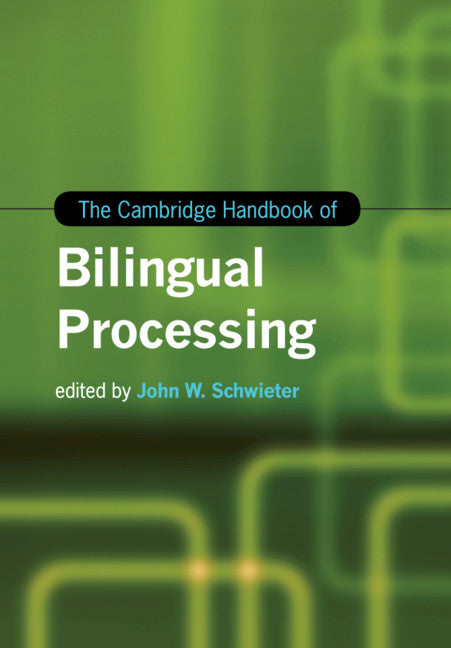Freshly Printed - allow 8 days lead
Couldn't load pickup availability
The Cambridge Handbook of Bilingual Processing
The Cambridge Handbook of Bilingual Processing presents a clear overview of current theories and findings in bilingual processing.
John W. Schwieter (Edited by)
9781107630765, Cambridge University Press
Paperback / softback, published 2 April 2020
859 pages, 31 b/w illus.
24.4 x 17 x 4.2 cm, 1.45 kg
'How can we control the use of multiple languages without massive confusion? Addressing this question forces us to explore an entirely new conceptualization of the human mind. This excellent handbook provides us with an invitation to this exploration by synthesizing core facts about non-selective access, early bilingual separation, transfer, interference, control processes, cues for code-switching, meaning merger, learning dynamics, and emotional grounding. Each of these topics is explored with careful attention to the use of converging methodologies to increase the precision of our models.' Brian MacWhinney, Carnegie Mellon University
How does a human acquire, comprehend, produce and control multiple languages with just the power of one mind? What are the cognitive consequences of being a bilingual? These are just a few of the intriguing questions at the core of studying bilingualism from psycholinguistic and neurocognitive perspectives. Bringing together some of the world's leading experts in bilingualism, cognitive psychology and language acquisition, The Cambridge Handbook of Bilingual Processing explores these questions by presenting a clear overview of current theories and findings in bilingual processing. This comprehensive handbook is organized around overarching thematic areas including theories and methodologies, acquisition and development, comprehension and representation, production, control, and the cognitive consequences of bilingualism. The handbook serves as an informative overview for researchers interested in cognitive bilingualism and the logic of theoretical and experimental approaches to language science. It also functions as an instrumental source of readings for anyone interested in bilingual processing.
Part I. Introduction: 1. Bilingual processing: a dynamic and rapidly changing field John W. Schwieter and Natasha Tokowicz
Part II. Theories and Methodologies: 2. Six decades of research on bilingual representation and processing Nan Jiang
3. Computational modeling of bilingual language acquisition and processing: conceptual and methodological considerations Ping Li and Xiaowei Zhao
4. Methods for studying adult bilingualism Michael Spivey and Cynthia Cardon
5. Methods for studying infant bilingualism Krista Byers-Heinlein
Part III. Acquisition and Development: 6. Becoming bilingual: are there different learning pathways? Núria Sebastián-Gallés
7. Phonology and morphology in lexical processing Kira Gor
8. Processing perspectives on instructed second language acquisition Bill VanPatten
9. Learning second language vocabulary: insights from laboratory studies Natasha Tokowicz and Tamar Degani
10. Second language constructions: usage-based acquisition and transfer Nick Ellis, Ute Römer and Matthew O'Donnell
11. Variability in bilingual processing: a dynamic approach Wander Lowie and Kees de Bot
Part IV. Comprehension and Representation: 12. Conceptual representation in bilinguals: the role of language specificity and conceptual change Panos Athanasopoulos
13. Emotion word processing within and between languages Jeanette Altarriba and Dana Basnight-Brown
14. Orthographic processing in bilinguals Walter van Heuven and Emily Coderre
15. Bilingual lexical access during written sentence comprehension Ana Schwartz
16. Cross-language interactions during bilingual sentence processing Paola Dussias, Amelia Dietrich and Álvaro Villegas
Part V. Production: 17. Individual differences in second language speech production Judit Kormos
18. Parallel language activation in bilinguals' word production and its modulating factors: a review and computer simulations Annette de Groot and Peter Starreveld
19. Cross-language asymmetries in codeswitching patterns: implications for bilingual language production Carol Myers-Scotton and Janice Jake
20. Intra-sentential code-switching: cognitive and neural approaches Janet van Hell, Kaitlyn Litcofsky and Caitlin Ting
Part VI. Control: 21. Selection and control in bilingual comprehension and production Judith Kroll, Jason Gullifer, Rhonda McClain, Eleonora Rossi and María Cruz Martín
22. On the mechanism and scope of language control in bilingual speech production Cristina Baus, Francesca Branzi and Albert Costa
23. Behavioural measures of language control: production and comprehension Julia Festman and John W. Schwieter
24. Neural perspectives of language control Arturo Hernandez
Part VII. Consequences of Bilingualism: 25. Cognitive consequences of bilingualism: executive control and cognitive reserve Ellen Bialystok and Fergus Craik
26. Does bilingual exercise enhance cognitive fitness in traditional non-linguistic executive processing tasks? Matthew Hilchey, Jean Saint-Aubin and Raymond Klein
27. Neural consequences of bilingualism for cortical and subcortical function Jennifer Krizman and Viorica Marian
28. How bilingualism shapes the mental lexicon Gary Libben and Mira Goral
29. Losing a first language to a second language Eve Higby and Loraine Obler
30. Moving beyond two languages: the effects of multilingualism on language processing and language learning Jared Linck, Erica Michael, Ewa Golonka, Alina Twist and John W. Schwieter.
Subject Areas: Bilingualism & multilingualism [CFDM], Psycholinguistics [CFD]


